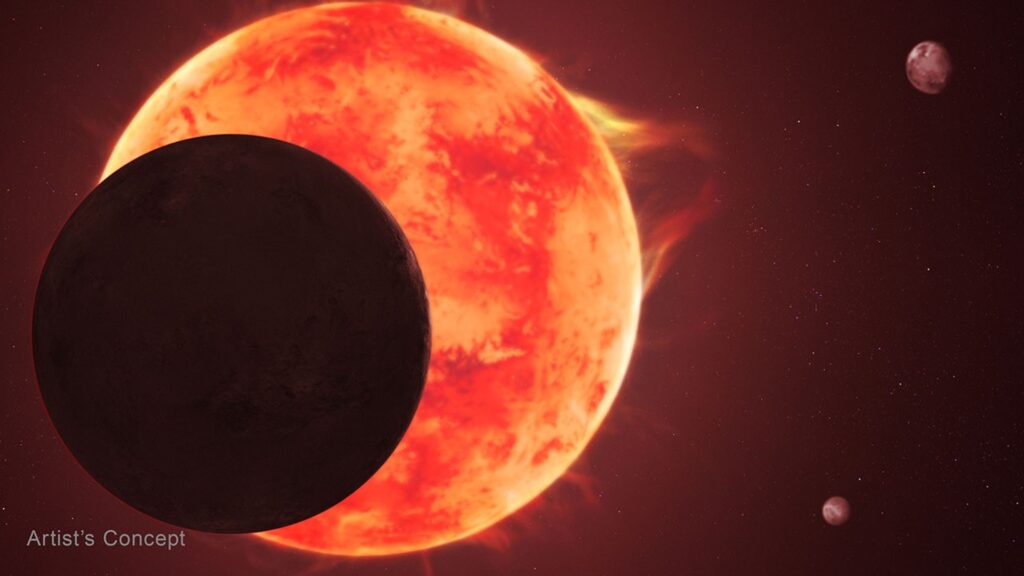
The exoplanet TRAPPIST-1d, a tantalizing candidate in the search for habitable worlds beyond our solar system, has revealed new atmospheric clues thanks to NASA’s James Webb Space Telescope. Despite its Earth-like size and rocky composition, TRAPPIST-1d does not possess an Earth-like atmosphere, according to a recent study published in The Astrophysical Journal.
Caroline Piaulet-Ghorayeb, the study’s lead author from the University of Chicago and the Trottier Institute for Research on Exoplanets at Université de Montréal, explained the significance of these findings. “Ultimately, we want to know if something like the environment we enjoy on Earth can exist elsewhere, and under what conditions. While NASA’s James Webb Space Telescope is giving us the ability to explore this question in Earth-sized planets for the first time, at this point we can rule out TRAPPIST-1d from a list of potential Earth twins or cousins,” she stated.
Understanding the TRAPPIST-1 System
Located 40 light-years away, the TRAPPIST-1 system gained attention in 2017 as the record-holder for the most Earth-sized rocky planets orbiting a single star. The system’s star, a dim, relatively cold red dwarf, creates a “habitable zone” much closer than that of our solar system. TRAPPIST-1d, the third planet from this star, orbits within this zone, completing a year in just four Earth days.
Despite its promising location, Webb’s NIRSpec (Near-Infrared Spectrograph) did not detect atmospheric molecules like water, methane, or carbon dioxide on TRAPPIST-1d. Piaulet-Ghorayeb suggested several possibilities for this absence, including a thin atmosphere similar to Mars, thick clouds akin to Venus, or no atmosphere at all.
The Challenges of Red Dwarf Stars
Orbiting a red dwarf star presents unique challenges for TRAPPIST-1d. These stars, while common in the Milky Way, are known for their volatility, often emitting flares of high-energy radiation that can strip away planetary atmospheres. However, the prevalence of red dwarf stars makes them a focal point for scientists seeking atmospheres on exoplanets.
“Webb’s sensitive infrared instruments are allowing us to delve into the atmospheres of these smaller, colder planets for the first time,” said Björn Benneke of IREx at Université de Montréal, a co-author of the study. “We’re really just getting started using Webb to look for atmospheres on Earth-sized planets, and to define the line between planets that can hold onto an atmosphere, and those that cannot.”
Future Prospects for TRAPPIST-1’s Outer Planets
Observations of the outer TRAPPIST-1 planets continue, offering both challenges and opportunities. Planets e, f, g, and h, being further from their energetic host star, may have a better chance of retaining atmospheres. However, their distance and colder environments complicate the detection of atmospheric signatures.
Piaulet-Ghorayeb remains optimistic. “All hope is not lost for atmospheres around the TRAPPIST-1 planets,” she said. “While we didn’t find a big, bold atmospheric signature at planet d, there is still potential for the outer planets to be holding onto a lot of water and other atmospheric components.”
Shawn Domagal-Goldman, acting director of the Astrophysics Division at NASA Headquarters, emphasized the importance of these studies. “NASA’s James Webb Space Telescope has pushed our capabilities for studying exoplanet atmospheres further than ever before, beyond extreme worlds to some rocky planets – allowing us to begin confirming theories about the kind of planets that may be potentially habitable. This important groundwork will position our next missions, like NASA’s Habitable Worlds Observatory, to answer a universal question: Are we alone?”
The Role of the James Webb Space Telescope
The James Webb Space Telescope, a collaboration between NASA, ESA, and CSA, stands as the world’s premier space science observatory. It continues to unravel mysteries within our solar system and beyond, probing distant worlds and the origins of the universe. As researchers harness its capabilities, the quest to find habitable planets and, ultimately, life beyond Earth, remains at the forefront of astronomical exploration.




